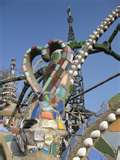Dream Something Big
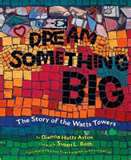 Dream Something Big: the Story of the Watts Towers, written by Dianna Hutts Aston with collages by Susan L. Roth, is a visually stunning biography of an artist you may never have heard of before. Simon Rodia was simply Uncle Sam to his neighbors in Los Angeles. Over 34 years, Sam built towers from broken bits of tile, glass, and cement that soar up to 99 feet high. His incredible recycled-art structures are now a National Landmark.
Dream Something Big: the Story of the Watts Towers, written by Dianna Hutts Aston with collages by Susan L. Roth, is a visually stunning biography of an artist you may never have heard of before. Simon Rodia was simply Uncle Sam to his neighbors in Los Angeles. Over 34 years, Sam built towers from broken bits of tile, glass, and cement that soar up to 99 feet high. His incredible recycled-art structures are now a National Landmark.
At the end of this gorgeously illustrated book you’ll find jaw-dropping photos of the Watts Towers. I’m including a close-up of the towers here so you can see the details as well as a photo that shows just how huge these works of art are. Share Dream Something Big with your students and do a fun math activity. Just how tall is a 99-foot tower? Get out the rulers and chalk and head to the playground or parking lot. Divide 99 by the number of students you have and let them take turns measuring and marking out each foot in 99 feet. Stand at one end of the length when you are done and imagine that distance soaring into the sky. Decorate the 99 feet with chalk “collages”, coloring bright shapes to resemble Sam’s art. Build your own towers with scrap materials, pipe cleaners, clay, etc. and encourage your students to “dream something big” like Sam did. For more inspiration, visit Dianna Hutts Aston’s website: diannahaston.com or Susan Roth’s website: susanlroth.com
Read MoreRah, Rah, Radishes!
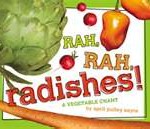 Three cheers for April Pulley Sayre and Rah, Rah, Radishes! A Vegetable Chant! How do you make healthy eating fun? With Sayre’s vibrant photos of vegetables taken at her local farmer’s market paired with her contagious rhymes:
Three cheers for April Pulley Sayre and Rah, Rah, Radishes! A Vegetable Chant! How do you make healthy eating fun? With Sayre’s vibrant photos of vegetables taken at her local farmer’s market paired with her contagious rhymes:
“Oh boy, bok choy!
Brussels sprout.
Broccoli. Cauliflower.
Shout it out!”
Start your lesson by asking students, “What do you think kohlrabi is? How about fennel? Rutabaga?” Read Rah, Rah, Radishes! and see if your kids can discover what those uncommon words mean. Encourage kids to chime in as you reread (“Go, green bean!”) Play “Cross the Line”: all the kids stand one one side of the classroom and imagine an invisible line down the middle of the room – or put down tape if your maintenance team won’t go nuts. Say “Cross the line if you’ve tried broccoli,” asparagus, the vegetables listed in the book. Have kids brainstorm vegetables that didn’t make the book. Is a tomato a vegetable? Find out in the back of Sayre’s book! If you have time and funds, bring in some vegetables for kids to try! Take photos of the vegetables and have kids use those Logic Smarts to sort the photos – by color, by part of plant (root, stem, leaf, or fruit), by which they liked and which they didn’t. With all the gorgeous colors of fresh produce, you can make a “color wheel” using vegetables – challenge kids to eat a rainbow! Rah, Rah, Radishes, hooray healthy eating, and super job, Ms. Sayre!
For more information, visit aprilsayre.com.
Read MoreThis Leap Year – Stick!
 With a title like Stick, you might not think this book by Steve Breen will work for a Leap Year celebration, but it will! Stick is an independent young frog; he likes to do things on his own, thank you very much. He doesn’t want help from his mom or anyone, until he “bites off more than he can chew” by zapping a dragonfly with his tongue. Now Stick is stuck – to a wildly flying dragonfly who pulls him, by the tongue, through the swamp and into New Orleans. His crazy adventure (which involves being plastered to the face of a motorcyclist and soaring on the beak of a seagull) brings him home only after he realizes that sometimes it’s good to ask for help.
With a title like Stick, you might not think this book by Steve Breen will work for a Leap Year celebration, but it will! Stick is an independent young frog; he likes to do things on his own, thank you very much. He doesn’t want help from his mom or anyone, until he “bites off more than he can chew” by zapping a dragonfly with his tongue. Now Stick is stuck – to a wildly flying dragonfly who pulls him, by the tongue, through the swamp and into New Orleans. His crazy adventure (which involves being plastered to the face of a motorcyclist and soaring on the beak of a seagull) brings him home only after he realizes that sometimes it’s good to ask for help.
After singing “Five Green and Speckled Frogs” (I encourage kids to leap like frogs every time one jumps into the pool), try this cooperative learning activity. We encourage our kids to be independent and that’s good, but it’s also good to be able to ask for help and to work as a team. For kids who prefer to do tasks alone, cooperative tasks can be challenging – especially if those kids feel they’d be able to complete the job better on their own! For a great cooperative learning activity, give your students jigsaw puzzles that are relatively challenging. Let them work in pairs or teams to put the puzzle together. This activity won’t be graded, so independent students who worry about others negatively affecting their grades can rest easy. Make sure the puzzles are hard enough to show those Self Smart kids that some things really are easier when we work together. It’s such a fun way to learn teamwork, you won’t want to wait four more years for your next Leap Year party to try it!
Read MoreQuiet Book and Loud Book
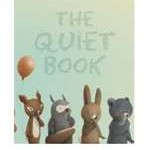 Because it’s February, I decided to dedicate today’s post to a couple of books I love: The Quiet Book and The Loud Book written by Deborah Underwood and illustrated by Renata Liwska. As a librarian, I find I’m partial to The Quiet Book! “There are many kinds of quiet:” Underwood writes. Some are lovely, like “Best friends don’t need to talk quiet” or “Making a wish quiet”. Some will bring giggles of recognition and “uh-ohs!” like “Jelly side down quiet” (I love the animals’ looks of distress as they see the jelly on the rug!) and some give words to feelings that are harder for little ones to express: “Last one to get picked up from school quiet”.
Because it’s February, I decided to dedicate today’s post to a couple of books I love: The Quiet Book and The Loud Book written by Deborah Underwood and illustrated by Renata Liwska. As a librarian, I find I’m partial to The Quiet Book! “There are many kinds of quiet:” Underwood writes. Some are lovely, like “Best friends don’t need to talk quiet” or “Making a wish quiet”. Some will bring giggles of recognition and “uh-ohs!” like “Jelly side down quiet” (I love the animals’ looks of distress as they see the jelly on the rug!) and some give words to feelings that are harder for little ones to express: “Last one to get picked up from school quiet”.
After reading The Quiet Book to kids, they’ll be begging to hear The Loud Book, but before you share it, brainstorm with them the different kinds of loud there are! They may come up with ideas similar to Underwood’s and get to have the thrill of “that’s like what I thought of!” I can imagine that your little ones will come up with some fantastically off-the-wall ideas,(and I encourage you to email Deborah Underwood and Renata Liwska with the best of your bunch!) but I can almost guarantee that they’ll be delightedly surprised with the ideas in the book they’d never considered. Some of my favorites: “Burp during quiet time loud”, “Candy wrapper loud” (Liwska draws the animals in the movie theater), and “Spilling your marbles in the library loud”.
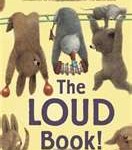 These two books together are perfect if you are working on the Common Core State Standard of Integrating Knowledge and Ideas. You can make a chart to compare the ways to be quiet and the ways to be loud and then try some of ways you’ve read about – preferably outside!
These two books together are perfect if you are working on the Common Core State Standard of Integrating Knowledge and Ideas. You can make a chart to compare the ways to be quiet and the ways to be loud and then try some of ways you’ve read about – preferably outside!
For more information, visit deborahunderwoodbooks.com or renataliwska.com.
Read More



